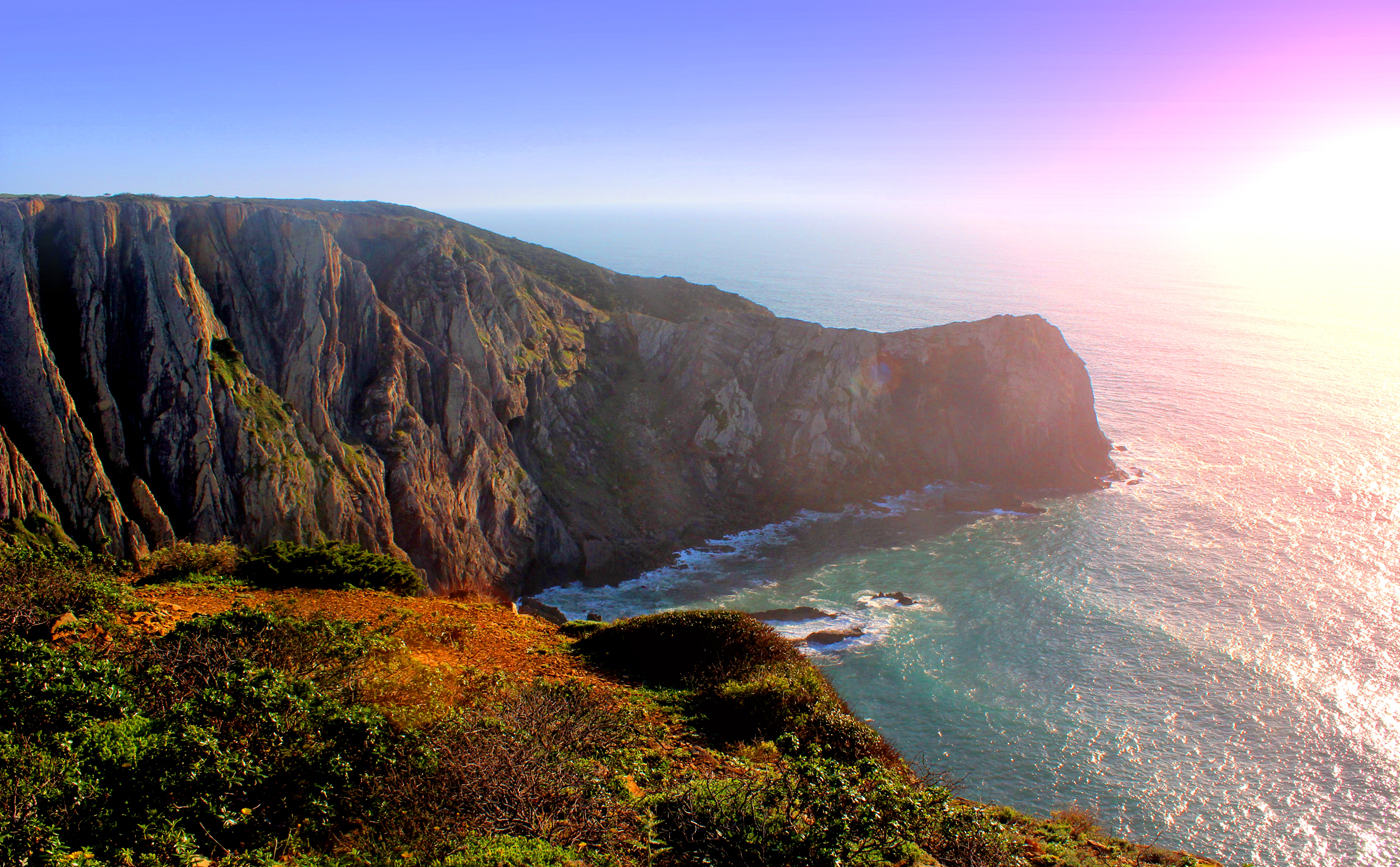
TRAIL FACTSHEET
BIRDS & NATURE | CASTELEJO: PLEASE SEE HERE.
Location: Castelejo, Vila do Bispo; Vila do Bispo municipality; GPS Coordinates (decimal degrees): 37.091138 N, -8.932220 W; Grade: easy; Type: loop trail; signposted trails; Lenght: 3500 meters/ 2.2 miles; Average Completion Time: 1.5 hours; Best Time to Visit: all year round; Activities: nature walks; BTT; birdwatching;
Most of the steep cliffs around Castelejo Beach are a stack of shale and sandstone rock layers formed during the Palaeozoic Era (544 – 230 Million Years Ago). Profoundly folded by extreme tectonic forces, this pliable bedrock was later pounded by powerful ocean waves, thus originating the rugged geological features we see nowadays. Today, together with the narrow gorges and rolling hills, the impressive rocky walls still create an assortment of quite diverse ecological niches.
In fact, the Costa Vicentina Natural Park is one of the last and most extensive natural spaces of its kind in Europe. The trail is located on the coastal plateau, close to the southernmost end of the Natural Park. At the start, it is possible to observe the fragrant Mediterranean maquis scrubland, largely comprised of thyme, lavender, rockrose and gorse, as well as strawberry and mastic trees. But its floral composition also incorporates a lot of rare and endemic plants, like the Biscutella (Biscutella vicentina) and the Firetree (Myrica faya).
 This place is heavily influenced by salty ocean winds. Such is the preferred habitat of the Dartford Warbler (Sylvia undata), a small passerine that needs the thorny gorse bushes to build the nest. Shade is provided by Maritime and Umbrella pines, as well as by some Eucalyptus trees, many of them unceremoniously distorted by the strong winter gales that blow particularly hard in this part of the Algarve. Following the main path, you’ll reach the small ‘warden’s house’, whose simple architecture is rather idiosyncratic of the time when Portugal was a right-wing dictatorship (‘Estado Novo’, 1933-1974).
This place is heavily influenced by salty ocean winds. Such is the preferred habitat of the Dartford Warbler (Sylvia undata), a small passerine that needs the thorny gorse bushes to build the nest. Shade is provided by Maritime and Umbrella pines, as well as by some Eucalyptus trees, many of them unceremoniously distorted by the strong winter gales that blow particularly hard in this part of the Algarve. Following the main path, you’ll reach the small ‘warden’s house’, whose simple architecture is rather idiosyncratic of the time when Portugal was a right-wing dictatorship (‘Estado Novo’, 1933-1974).
The trail circumvents the house to the right and starts its descent into the small gorge. At this spot, there is a shallow pond that provides temporary refuge for some amphibians, and it may be possible – depending on the season – to observe species such as the Western Spadefoot Toad (Pelobates cultripes) or the Iberian Parsley Frog (Pelodytes ibericus). There, on the sides of the main path, be watchful of floral species like the Heart-flowered Serapias orchid (Serapias cordigera) and birds such as the Blue Rock Thrush (Monticola solitarius), the Great Spotted Woodpecker (Dendrocopos major) and the Eurasian Jay (Garrulus glandarius). The trail runs parallel to a small water stream bordered by giant Reeds, Bulrush and African Tamarisk (Tamarix africana), a tree native to the arid regions of Africa and Eurasia. Gradually leaving behind the lowest areas, you will then clearly distinguish a glowing stretch of the ocean where the chevron-shaped valley encounters Castelejo Beach, one of the many stunning spots along this truly remarkable coastline.
There is a small parking lot where the trail starts. As that particular place also doubles as a little playground and picnic area, it may be somewhat harder to find available space during the summer months. The exact point where the trail starts is not conspicuous: if you’re arriving by car, make sure that you actually cross Vila do Bispo village from the inside and then take road 1265. The parking lot/small leisure area is located on the left-hand side of this road that ends at Castelejo Beach. The wind and atmospheric humidity during the coldest months (November-February) may be substantially increased. Depending on the time of the year, any of the aforementioned species can be observed in the area around Castelejo. However, if your prime objective is ‘pure’ birding, there are in fact better and nearby places to observe the birds, such as Cape St. Vincent (Portuguese: ‘Cabo de São Vicente’), Vale Santo and Cabranosa – please refer to the Birding Hotspots page in order to plan a visit to those places.
 Then you may want to visit the many wonderful vantage points located along this region. Besides Cape St. Vincent, nearby you’ll also find the Torre de Aspa lookout (pictured) and the Castelejo viewing point. Both afford terrific, panoramic viewing points (please check the map markers above). Reaching a height of 160 meters – about 525 feet – the area around Torre de Aspa has some of the highest sea cliffs in the Algarve. The dirt roads leading to them are quite rough, but they are easily and safely reachable by car (albeit slowly). When enjoying the landscape, always keep a safe distance from the edges of the cliffs. If you love seafood, you’ll find plenty of traditional restaurants serving the freshest of fish in Vila do Bispo municipality, particularly in Sagres. Stick to the traditional bistros, taste a ‘cataplana’, drown the fish with a well chilled ‘vinho verde’ wine, and you’ll feel richly rewarded. Enjoy!
Then you may want to visit the many wonderful vantage points located along this region. Besides Cape St. Vincent, nearby you’ll also find the Torre de Aspa lookout (pictured) and the Castelejo viewing point. Both afford terrific, panoramic viewing points (please check the map markers above). Reaching a height of 160 meters – about 525 feet – the area around Torre de Aspa has some of the highest sea cliffs in the Algarve. The dirt roads leading to them are quite rough, but they are easily and safely reachable by car (albeit slowly). When enjoying the landscape, always keep a safe distance from the edges of the cliffs. If you love seafood, you’ll find plenty of traditional restaurants serving the freshest of fish in Vila do Bispo municipality, particularly in Sagres. Stick to the traditional bistros, taste a ‘cataplana’, drown the fish with a well chilled ‘vinho verde’ wine, and you’ll feel richly rewarded. Enjoy!
